Aunt Vadge: How do oral biofilm enzymes get to the vagina?
Ever wondered how an enzyme taken by mouth can impact vaginal biofilms? Aunt Vadge explains!
Bacterial biofilms: what is extraceullar DNA? (EDNA)
How bacteria build their fortresses: the secrets of extracellular DNA and how they are used to make biofilms/
The microbiome of the penis, semen and male reproductive tract
The penile microbiome is being examined for its role in fertility, infections and interactions with the vaginal microbiome.
Impact of Cinnamomum on Pseudomonas aeruginosa biofilms
Cinnamomum, one of the active constituents of cinnamon, has strong antibacterial and antibiofilm activity against P. aeruginosa.
The neovaginal microbiome
Recent studies have begun to shed light on the neovaginal microbiome, revealing a fascinating interplay between penile, intestinal, and hormonal influences.
The science behind cinnamon’s significant biofilm activity
Cinnamon is a potent therapeutic agent in combating bacterial and fungal biofilm-associated infections.
Impact of Cinnamomum on Staphylococcus aureus biofilms
Staph biofilms are susceptible to some of the active constituents in cinnamon, making Cinnamomum a possible treatment avenue for resistant infections.
What is FUT2 and how does it affect my vagina?
FUT2 mutations disrupt microbiome health, increasing vulnerability to infections, gut issues, and nutrient deficiencies.
Impact of Cinnamomum on Candida spp.
Cinnamon extracts are showing enormous promise as an antibiofilm agent against Candida species.
How to get a comprehensive vaginal, urinary and semen microbiome test
Get accurate testing based on your needs via thorough vaginal and urinary microbiome testing.
Understanding vaginal pH
We explain vaginal pH and how it relates to your vaginal smells. If you have a funny smell coming out of your vagina and need to test your vaginal pH, we explain how.
Microbes that gentian violet is effective (and ineffective) against
Look over the list of bacteria that gentian violet will be effective against to make sure your bacterial vaginosis bacteria is on the list. If it's not, you'll need to check the support section for the comparison chart of treatment options.
What is a facultative anaerobe? How bacteria ‘breathes’ (or not)
We briefly discuss what makes a vaginal bacteria able to survive in both oxygen-rich and oxygen-deprived environments, with bacterial vaginosis and aerobic vaginitis bugs as our examples.
Using InterFase Plus – penis (Killing BV)
We explain how to use InterFase or InterFase Plus as a penis treatment for BV-related biofilms in men, with clear instructions for dosage and application.
Understanding E. coli biofilms in recurrent UTIs
We look into E. coli's biofilms in a bit more detail, explaining exactly why biofilms contribute to recurrent urinary tract infections and other vaginal infections.
Escherichia coli (E. coli) in urinary tract infections
We explain E. coli and how it works in urinary tract infections.
Strong ammonia smell in vagina – which bacteria you have in BV
We delve into what bacteria cause ammonia smells to come from your vagina, especially with a diagnosis of BV. There are only a few bacteria that cause ammonia-like vaginal odours, so you can narrow it down and get effective treatment.
BV mouth treatment (Killing BV)
How to get BV out of your mouths! Discover a 7-day oral treatment to help combat vaginal BV - and get fresher breath.
BV – you also probably have it in your mouths
Discover how BV links to oral health issues. Learn about the research on BV's impact on the mouth and gums and get effective treatment.
What is a clue cell in bacterial vaginosis diagnostics?
A clue cell is an epithelial (skin) cell from the vaginal walls that has been shed, but is coated in bacteria. We take a quick look at the clue cell, which is a key part of bacterial vaginosis diagnosis.








